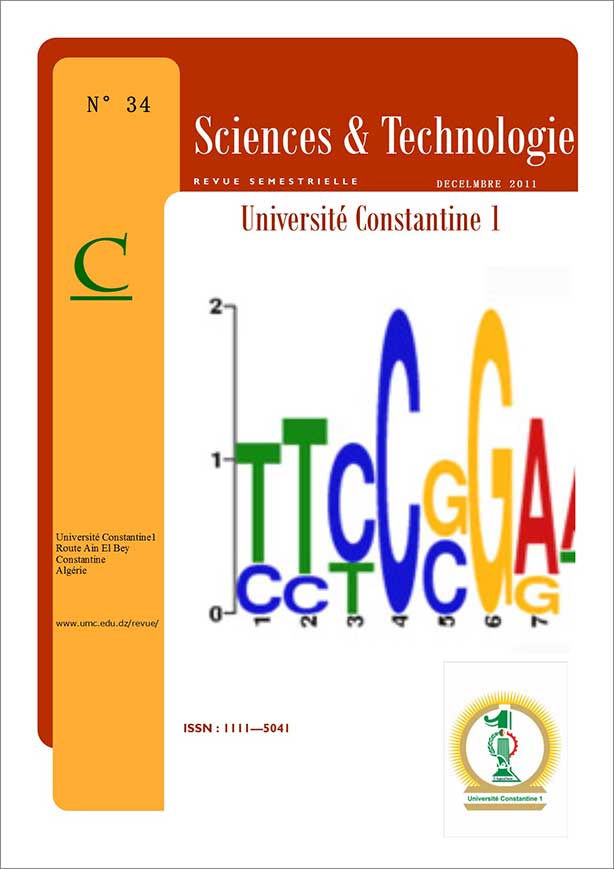CONTRIBUTION DU DIAGNOSTIC BIOCHIMIQUE BACTERIEN DANS L’ETABLISSEMENT DES PARENTES PHYLOGENETIQUES : CAS DES EnterobacteriaceaeET Pseudomonas sp
Mots-clés :
Enterobacteriaceae, Pseudomonadaceae, phenotype, phylogenyRésumé
Ten bacterial strains were isolated from clinical samples provided by the bacteriology laboratory (Daksi, Constantine).Among the ten strains studied, eight belong to the Enterobacteriaceaeand two are among the Pseudomonadaceae. These strains were presumptively identified by their biochemical characteristics, susceptibility or resistance to antibiotics, and total nitrogen measured by the Kjeldahl method. A phylogenetic profile was produced by phenetic methods based on the calculation of genetic distances using the Neighbor Joining algorithm (NJ) and bioinformatics analysis of 16S rRNA sequences to compare the two phylogenies (phenotypic and genotypic). The analysis of topologies obtained showed that the biochemical phenotype has some limitations in bacterial identification and sequence analysis of 16S rRNA is a key tool in bacterial identification across the case.
Références
Weber P., Dib C., Durand C. (2005). Evaluation de la sensibilité à la lévofloxacine des souches isolées d’infections urinaires basses communautaires. Pathol Biol. 53: 8-125.
Les recommandations du comité de l’antibiogramme (CA–SFM). (2010). [En ligne] http://www.sfm.asso.fr
Kjeldahl J. (1883). Neue Methode zur Bestimmung des Stickstoffs. In organischen Körpern. Z. Anal. Chem. 22:366-382.
http://mobyle.pasteur.fr/cgi- bin/portal.py
Holt J.G., Krieg N.R., Sneath P.H.A., et al. (1994). Bergey’s manual of determinative bacteriology. Williams & Wilkins. Baltimore. 787 p.
Prescott L.M., Harley J.P., Klein D.A., et al. (2003). Microbiologie. 2ème édition. Boeck Université. 1099 p.
Joffin J.N., Leyrol G. (2006). Microbiologie technique. Tome1. Dictionnaire des techniques. Bordeaux : CRDP d’aquitaine. 363 p.
Pilet C., Bourdon J.L., Toma B., et al. (1979). Les entérobactéries : Bactériologie médicale et vétérinaire : systématique bactérienne. Doins. Paris. p.109-187.
Davis J.A., Jackson C.R., Fedorka-Cray P.J., Barrett J.B., Brousse J.H., Gustafson J., et al. (2011). Anatomical distribution and genetic relatedness of antimicrobial-resistant Escherichia coli from healthy companion animals. Journal of Applied Microbiology. 110 (2) : 597-604.
Ferjani A., Mkaddemi H., Tilouche S., Marzouk M., Hannechi N., Boughammoura L., et al. (2011). Caractéristiques épidémiologiques et bactériologiques des bactéries uropathogènes isolées dans un milieu pédiatrique. Archives de Pédiatrie. 18 (2) : 230-234.
Barker I.K., Allen S.E., Boerlin P., Janecko N., Lumsden J.S., Pearl D.L., et al. (2010). Antimicrobial Resistance in Generic Escherichia coli Isolates from Wild Small Mammals Living in Swine Farm, Residential, Landfill, and Natural Environments in Southern Ontario, Canada. Applied and Environmental Microbiology. 77 : 882-888.
Avril J-L., Dabernat H., Denis F. et al. (2000). Bactériologie Clinique. Ellipses. 601 p.
Susana S., Bostjan J., Roman J., Ignacio M., Mirian F.,José L., et al. (2011). Structural Features Governing the Activity of Lactoferricin-Derived Peptides That Act in Synergy with Antibiotics against Pseudomonas aeruginosa in vitro and in vivo. Antimicrobial Agents and Chemotherapy. 55 (1) : 218-228.

